
Contact

Home
Loch Ness Monster part 8

1934

continued
The Advertiser (Adelaide, SA)
Date: January 22, 1934
Page Number: 8
...
Mr. N. A. Webb proposed "The Land o' Cakes." Scotland, he said was Peopled by all sorts of strange animals. They had heard a lot about one at Loch Ness, but he was Scotch, and kept away from the people who desired to photo graph him. (Laughter.) The Scotch had been the greatest colonists in Australia.
...
Gippsland 'Monster'
TRACKERS FOLLOW SUPPOSED CLAW MARKS
Townsville Daily Bulletin (Qld.)
Date: January 23, 1934
Page Number: 8

MELBOURNE, To-day.
The Loch Ness monster or one of his bigger or smaller brothers has broken out in a new place—or at least some people thought so.
Strange animals, resembling tigers and lions, have been reported in South Gippsland recently, and when some "strange" footmarks were discovered near Traralgon, residents, armed with rifles, decided to trail them.
The trackers followed what they thought were claw marks, but when they came to the end of the trail they found that the marks had been left by a local tradesman.
He lost his boots when trying to get through deep clay, caused by a landslide, and finished his journey in bare feet.
LOCH NESS MONSTER.
Chronicle (Adelaide, SA)
Date: February 1, 1934
Page Number: 36

NINE DAY WONDERS
Strange Things People Believe
The Advertiser (Adelaide, SA)
Date: February 2, 1934
Page Number: 7

Barnum, the great showman, made his money through the belief that "all the world loves a monster." The freaks he exhibited drew crowds in every part of the world. Most of them could be termed "nine-day wonders," a description that applies to the monster that is said to lurk in the depths of Loch Ness in Scotland. An enterprising showman in London has offered £20,000 to the person who brings it to him alive, and the loch is teeming with hunters anxious to win the prize. Whether the animal is real or not, the fact remains that a vast number of people believe in it. Faith in the existence of sea serpents and other creatures is widespread, and in this week's "Express and Journal" some amazing facts are revealed about public credulity. In Europe there are still people who assert that national heroes, like Frederick the Great, Charlemagne, and Ivan the Great are still alive, and people of today will recall how persistent was the legend that Lord Kitchener escaped destruction in the Hampshire. Faith in prophets who announce the date of the end of the world is also general, despite the long list of unfulfilled prophecies that the article mentions.
...
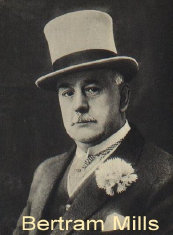
Bertram Wagstaff Mills (August 1873 – April 16, 1938) was a British circus owner who ran the Bertram Mills Circus.

In 1933 Bertram Mills took his circus to Inverness along the new A82 for the first time, where his road crew would have stopped along
the banks of Loch Ness to rest and feed the animals. Coincidentally that was when the sightings of the Loch Ness Monster began. Bertram
Mills, ever the entrepreneur, quickly used the local story to his advantage by offering the £20,000 (nearly £2 million pounds today)
to anybody who could prove that they had seen the great beast.
It was a sum Mills seemed suspiciously unable to afford to pay out. But the public flocked to the area nevertheless, sightings soared
and more people than ever before attended his shows in case the monster might make an appearance. But how could Mills have been so
sure nobody could legitimately claim the reward?
AMERICAN GOLD DECISION
Britain Taken by Surprise
POSSIBLE EFFECT ON EXCHANGES
The Daily News (Perth, WA)
Date: February 2, 1934
Page Number: 5

...
The "Times," in a leading article, says that the control that Mr. Roosevelt is able to exercise over American currency credit enables a more vigorous pursuit of the policy on which he and Mr. MacDonald agreed in April, including the ultimate re-establishment of equilibrium in international exchanges, thereby proving the falsity of panicky prognostications of a currency war, which were given plausibility by nonsense talked in Washington regarding the British exchange fund, which was apparently regarded as a sort of Loch Ness monster. There have recently been signs that the necessity for an Anglo-American currency under standing have been more widely recognised. It would be in the interests of both countries and international trade if the American fund were used like the British to encourage Anglo-American exchange to find the natural equilibrium and restrict fluctuations due to speculators and the nervousness of the money market.
...
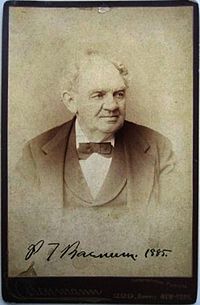

Phineas Taylor Barnum (July 5, 1810 – April 7, 1891) was an American showman, businessman, scam artist and entertainer, remembered for promoting celebrated hoaxes and for founding the circus that became the Ringling Bros. and Barnum & Bailey Circus.


Frederick
the Great
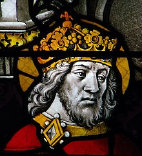

Charlemagne
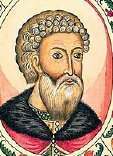

Ivan
the Great
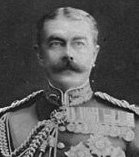

Lord Kitchener
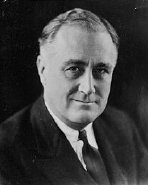

Franklin D. Roosevelt
c 1933
The Monster Again
The Advertiser (Adelaide, SA)
Date: February 3, 1934
Page Number: 11

INTEREST in the Loch Ness monster continues unabated, particularly as he has been sighted again and a big game hunter has found his spoor among file bracken, bordering the loch. He says he found marks of pad-like feet, apparently somewhat like a camel's, about nine inches in diameter leading into the water. A Fort Augustus doctor declares he has seen the beast twice in the last month, the last time last week, in the region of Glendoe. It was then travelling with a leaping motion, and a portion of its body, about 10 feet long, stood 3 feet out of the water. The animal, which at the same time is protected by the local constabulary, and has a price of £20,000 upon it, if captured alive, has caused much activity among visitors during the holidays, but its timidity is its protection. Sir. J. C. Squire, the writer, suggests that it is hardly fair to call such a "timorous beastie" a monster, and thinks it might at least, with due regard to the locality, be softened to "monstuhar" (cf. Farquhar) or "Monstquhar" (cf. Colquhoun). On the other hand, he ventures that this may put the offence at only one remove from Englishmen and at no remove from the Scots. As a further alternative, until the mammal or fish is identified, he proposes the MacKraken, or the Ness of Ness, or even MacNess. "Of course," he adds, in the course of a letter to "The Times" on the subject, "if the monster turns out to be a female, with or without a brood of little Monstquharsons, a good deal of my argument falls to the ground."
The Scottish controversy has produced scores of anecdotes about sea monsters from all over the world. "Deutsche Allgemeine Zeitung" prints a story by Baron von Forstner, who reports that in 1915, when in charge of the submarine U-28, he torpedoed the British steamer Iberian in the Atlantic. About 25 seconds after her disappearance the German seamen heard a loud detonation and saw together with pieces of wreckage, a monster of the deep, which made convulsive movements, thrown from 70 to 100 feet into the air. It was from 60 to 70 feet in length, "rather like a crocodile, with two fore and two hind legs with powerful fins, and a long pointed head."
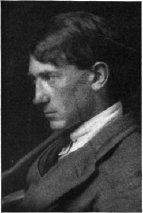
Sir John Collings Squire
(2 April 1884 – 20 December 1958)
British poet, writer, historian, and influential literary editor of the post-World War I period.

The Sydney Morning Herald (NSW)
Date: February 6, 1934
Page Number: 12

THAT ELUSIVE MONSTER.
The Sydney Morning Herald (NSW)
Date: February 6, 1934
Page Number: 8

The Loch Ness "monster," about which London refuses to grow excited, is like the sea serpent that was "sighted" a few years ago off Bondi. All sorts of people have seen it, but nobody can discover it. Those who solemnly swear that they have glimpsed the creature "with their own eyes" say that it is "very large," but as to its shape, they are vague. Whether it has fins or legs, or both, we have not been told. We do not even know if it is an animal or a fish. Cynics declare, of course, that it is neither. They state, quite emphatically, that it is merely a submerged log.
Frantic efforts to solve the mystery have so far proved unavailing. The Loch has been searched from the air, from boats, and from the land, with disappointing result. Only when the searchers have disappeared does the monster emerge from its submarine fastness (or so we are asked to believe). It then basks in some secluded inlet, and perhaps takes a short ramble ashore, judging by certain "spoors" that have been found. These tracks have evoked so much curiosity that there is talk of a really serious "expedition." Two "ex-offlcers" have advertised that they have devised an entirely "practicable scheme" for effecting a capture, and promise that once caught the monster shall be "the sole property" of "any sportsman, scientist, or syndicate" which cares to finance the operations. So far, there seems to have been a dearth of sportsmen, scientists, and syndicates with sufficient enthusiasm for the project, notwith- standing that the advertisement winds up with an assurance of "perfectly good references."
Still, hardly a week passes without somebody reporting fresh evidence of the monster's existence, though, often enough, the witnesses admit the possibility of having mistaken the shadow for the substance. Movie cameras and telescopes have been trained on the Loch (now thronged as for a regatta) with unremitting persistence, but the public vet awaits an authentic portrait of something more substantial and thrilling than a fleeting shadow.
The Central Queensland Herald (Rockhampton, Qld.)
Date: February 8, 1934
Page Number: 16

I FIND that Scotsmen, of whom there are said to be a number in London, resent aspersions cast on the Loch Ness "Monster." With them it is a matter of pride that Scotland possesses the only even partially authentic specimen of the sea serpent, and they do not like mere Southerners even doubting or ridiculing the beast. As a rule the Scot is a more logical person than the Saxon, yet I am quite at a loss to follow the logic of one argument, advanced in affirmation of the "monster" by a Scots professor. He argued that a sea snake of prehistoric mould in Loch Ness was no more incredible than the phenomenon of sea shells on Arthur's Seat. He asked me to explain how the sea shells got there, and, when I confessed my inability, not being strong on geology he said; "Then dinna fash yersel' about the snake!" Unfortunately I had not then seen the published photo of a waterlogged tree trunk, floating on Loch Ness, which looks just like a sea serpent.
Minister Sees Sea Serpent.
MINISTERIAL scepticism regarding the Loch Ness "monster" is official and not unanimously personal. One member of the Government, who was a seafarer in his youth, admits to his friends that in the Indian Ocean one morning the captain handed him his binoculars and pointed to a large animal disporting itself in the water. it was duly entered in the log-book as "a serpentine monster." That was forty years ago or more, but the Minister in question, whose identity had better remain a mystery, does not feel confident that the Loch Ness visitant is purely imaginary.
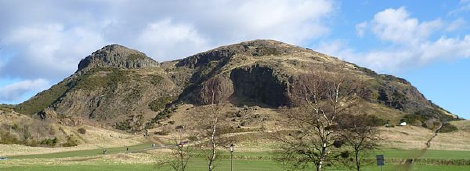

Arthur's Seat, Edinburgh
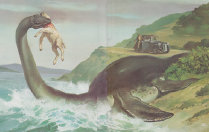
Contents
(By Robert S. Angus).
EDINBURGH, December 18, 1933.
I have said so little hitherto about the "Loch Ness monster," and it has been so much talked and written about, that I begin to suspect myself of failure of duty to my readers. The subject has even found its way into the House of Commons and the Scottish Secretary has given instructions to the local police that they are to
issue warnings against any interference with the animal. At first I was disposed to think that the Highland sense of humour was being exercised at the expense of the credulous southerner, and that shrewd tradesmen were encouraging the story for the sake of attracting visitors, especially inquisitive journalists, at a time of year when visitors are few. But the evidence collected by a gentleman who is the recognised authority on the sea-serpent and narrated to the extent of over two columns in "the Times" does suggest that the Loch has some inhabitant of an unknown type. How an animals of the size indicated can have got there through the narrow passages into the Loch is a mystery. On the other side of the account I set the experience of a professional friend who went to investigate for himself. All forenoon he scanned the waters of the Loch through his binoculars with out seeing anything. At lunch time he dashed into tne local inn, and on his return twenty minutes later he was assured that in his absence no fewer than six persons had seen the "monster." But during the afternoon it did not reappear.
Townsville Daily Bulletin (Qld.)
Date: January 23, 1934
Page Number: 8


































